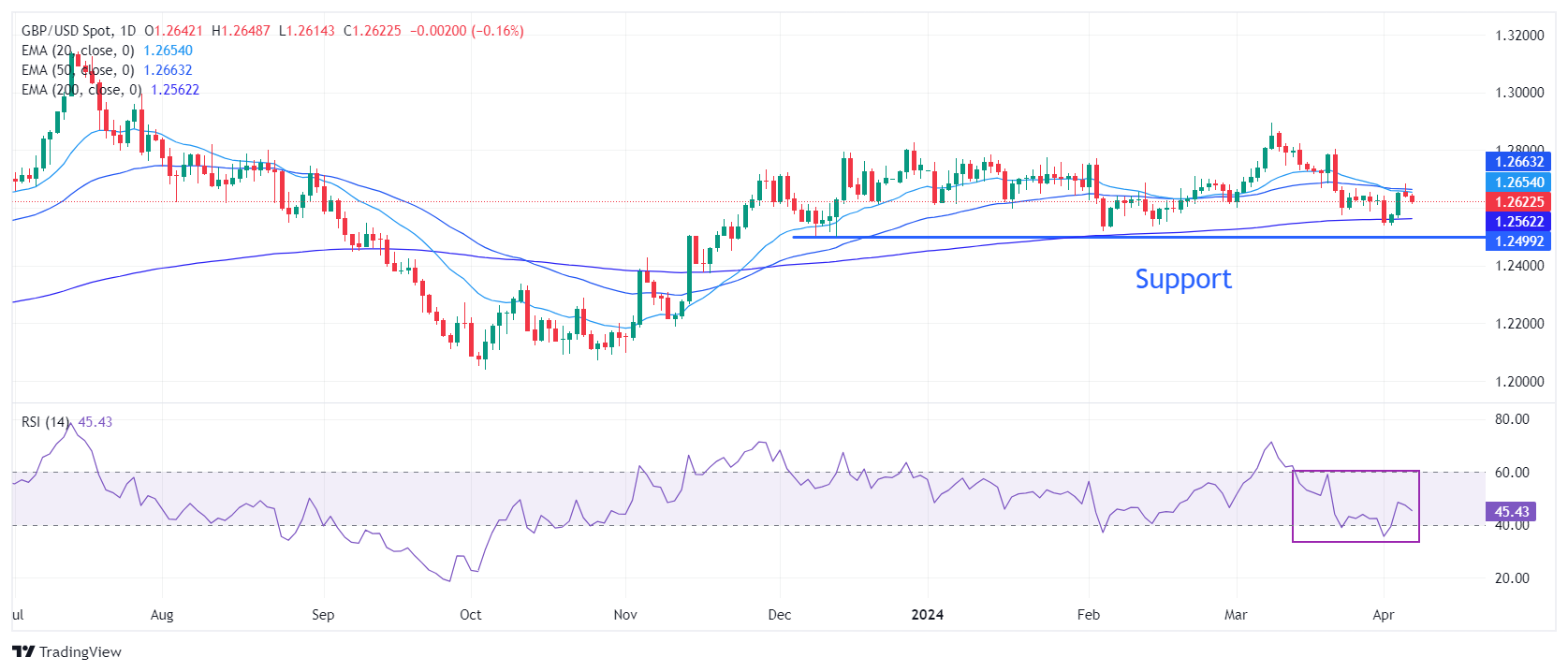- The British pound declines from 1.2680 as rising tensions in the Middle East hurt risk-sensitive currencies.
- The sharp drop in inflation expectations in the UK improves hopes of an early rate cut by the BoE, weighing on the GBP.
- US Dollar bounces after good Non-Farm Payrolls data
The British pound (GBP) falls sharply to 1.2600 in the American session on Friday. The GBP/USD pair weakens as encouraging US March Non-Farm Payrolls (NFP) data has boosted demand for the US Dollar.
The labor market report showed that February NFP rose to 303,000, against expectations of 200,000 and the previous reading of 270,000, revised down from 275,000. The unemployment rate fell to 3.8%, compared to expectations and the previous reading of 3.9%. Annual hourly earnings grew 0.3%, as expected on a month-on-month basis. Annual wage growth slowed to 4.1%, compared to the expected 4.3%.
Strong demand for labor leading to higher wage growth, spurring inflation, would allow the Federal Reserve (Fed) to delay rate cut plans. On Thursday, Minneapolis Fed Bank President Neel Kashkari warned that rate cuts will not be necessary this year if inflation stagnates. Kashkari also said that he was forecasting two rate cuts by 2024 in the latest dot chart.
Meanwhile, easing inflation expectations in the UK have also weighed on the Pound. The Bank of England's (BoE) Decision Makers Panel's (DMP) latest survey for February showed that most businesses expect selling price and wage inflation to cool during the year. next year. Selling price expectations slowed to 4.1% from 4.3%, the lowest reading in more than two years. Wage growth expectations softened to 4.9% on a three-month moving average, from 5.2% in February.
Falling inflation expectations are expected to boost BoE rate cut expectations for the June meeting. Rising hopes that the BoE will soon cut rates weighs negatively on the Pound.
Daily summary of market movements: Fall of the Pound Sterling and advance of the US Dollar
- The British Pound extends its correction to 1.2600 due to the markets' caution. Heightening tensions in the Middle East and the easing of Federal Reserve rate cut expectations for June, following the upbeat March NFP report in the United States, have boosted the US Dollar's recovery.
- The US Dollar Index (DXY) rebounds from a two-week low of 103.90. The death of seven members of Iran's Islamic Revolutionary Guard Corps (IRGC) by airstrikes by Israeli forces in Damascus has deepened fears of direct Iranian involvement in the Israel-Palestine war.
- Sterling falls as investors expect the Bank of England to pivot towards a rate cut in June as price pressures ease. Expectations that the BoE will cut rates from June were reinforced after BoE Governor Andrew Baily said market expectations of two or three rate cuts this year are reasonable.
- Meanwhile, weak UK services PMI data for March, released on Thursday, has weighed on the economic outlook. The services PMI fell to 53.1, below expectations and the previous reading of 53.4. Tim Moore, Chief Economics Officer at S&P Global Market Intelligence, said: “The service sector output recovery lost a bit of momentum during March, and more than the preliminary PMI results suggest, but the overall picture remains reasonably positive.”
Technical Analysis: British Pound Faces Pressure Near 1.2680

The British pound continues to fall after retreating from its two-week high at 1.2680. The GBP/USD pair fails to stay above the 20-day and 50-day EMA, which are trading around 1.2660. Meanwhile, the 200-day EMA at 1.2566 continues to provide support.
On a longer time frame, horizontal support from the December 8 low at 1.2500 would provide further cushion to the British Pound. Meanwhile, rallies are expected to remain limited near an eight-month high around 1.2900.
The 14-period Relative Strength Index (RSI) bounces above 40.00 after falling below. This should not be considered a “bullish reversal” until it decisively breaks above 60.00.
Nonfarm Payrolls FAQ
What are non-farm payrolls?
Nonfarm payrolls (NFP) are part of the monthly employment report from the US Bureau of Labor Statistics. The nonfarm payrolls component specifically measures the change in the number of people employed in the US during the previous month, excluding the agricultural sector.
How do nonfarm payrolls influence the Federal Reserve's monetary policy decisions?
The nonfarm payrolls figure can influence Federal Reserve decisions by providing a measure of how successfully the Fed is fulfilling its mandate of promoting full employment and 2% inflation.
A relatively high nonfarm payroll figure means that more people are employed, earning more money, and therefore likely spending more. Conversely, a relatively low nonfarm payrolls result could mean that people have difficulty finding work.
The Federal Reserve typically raises interest rates to combat high inflation caused by low unemployment, and lowers them to stimulate a stagnant labor market.
How do non-farm payrolls affect the US dollar?
Non-farm payrolls typically have a positive correlation with the US Dollar. This means that when payroll numbers are higher than expected, the Dollar tends to rise and vice versa when they are lower.
The NFP influences the US Dollar through its impact on inflation, monetary policy expectations, and interest rates. A higher NFP usually means that the Federal Reserve will be tighter in its monetary policy, which supports the USD.
How do non-farm payrolls affect the price of Gold?
Non-farm payrolls usually have a negative correlation with the price of Gold. This means that a higher than expected payroll figure will have a depressive effect on the price of Gold and vice versa.
A higher NFP usually has a positive effect on the value of the USD, and like most major commodities, Gold is priced in US Dollars. Therefore, if the USD gains value, fewer Dollars are needed to buy an ounce of Gold.
Furthermore, higher interest rates (usually aided by a higher NFP) also reduce the attractiveness of Gold as an investment compared to staying in cash, where the money will at least earn interest.
Sometimes nonfarm payrolls provoke a reaction opposite to what the market expects. For what is this?
Nonfarm payrolls are just one component within a larger employment report and can be overshadowed by the other components.
Sometimes, when nonfarm payrolls beat forecasts but average weekly earnings are lower than expected, the market has ignored the potentially inflationary effect of the headline result and interpreted the drop in earnings as deflationary.
The Participation Rate and Average Weekly Hours components can also influence the market reaction, but only on rare occasions, such as in the “Great Resignation” or the Global Financial Crisis.
Source: Fx Street
I am Joshua Winder, a senior-level journalist and editor at World Stock Market. I specialize in covering news related to the stock market and economic trends. With more than 8 years of experience in this field, I have become an expert in financial reporting.







